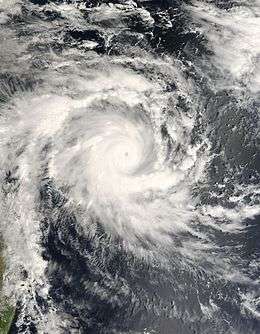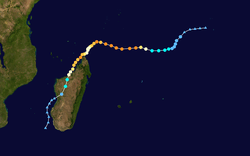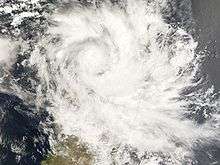Cyclone Bondo
Intense Tropical Cyclone Bondo was the first of a series of six tropical cyclones to impact Madagascar during the 2006–07 South-West Indian Ocean cyclone season. Bondo developed on December 15 in the central Indian Ocean, west of Diego Garcia. After strengthening into a moderate tropical storm on December 18, the storm rapidly intensified while moving westward, taking advantage of favorable atmospheric conditions. Within 18 hours of being named, Bondo intensified to tropical cyclone status, or the equivalent of a minimal hurricane. The Météo-France office on Réunion (MFR) estimated peak 10 minute sustained winds of 205 km/h (125 mph), although the American-based Joint Typhoon Warning Center estimated stronger 1 minute winds of 250 km/h (155 mph). While near peak intensity, Bondo passed just south of Agaléga island, before weakening slightly and moving through the Farquhar Group of islands belonging to the Seychelles, becoming the strongest cyclone to affect that island group in decades. Bondo turned southwestward, and after brushing the northern coast of Madagascar, the cyclone made landfall near Mahajanga on December 25. The storm continued southward, and was last tracked by the MFR on December 28.
| Intense tropical cyclone (SWIO scale) | |
|---|---|
| Category 4 tropical cyclone (SSHWS) | |
 Intense Tropical Cyclone Bondo on December 20 | |
| Formed | December 15, 2006 |
| Dissipated | December 28, 2006 |
| Highest winds | 10-minute sustained: 205 km/h (125 mph) 1-minute sustained: 250 km/h (155 mph) Gusts: 285 km/h (180 mph) |
| Lowest pressure | 930 hPa (mbar); 27.46 inHg |
| Fatalities | 11 direct, 1 missing |
| Areas affected | Agaléga, Seychelles, Madagascar |
| Part of the 2006–07 South-West Indian Ocean cyclone season | |
Due to its small size, Bondo's winds did not exceed 100 km/h (62 mph) on Agaléga, despite passing close by near peak intensity. In the Seychelles, Bondo severely damaged buildings and vegetation on Providence Atoll. High waves caused flooding elsewhere in the archipelago. In Madagascar, Bondo killed 11 people when it struck the island's west coast. The storm's high winds, reaching 155 km/h (96 mph) in Mahajanga, damaged buildings and left around 20,000 people homeless.
Meteorological history

An area of convection, or thunderstorms, persisted west of Diego Garcia in the central Indian Ocean on December 15. That day, the Météo-France meteorological office in Réunion (MFR)[nb 1] classified the weather disturbance as Tropical Disturbance 3. Over the next two days, the disturbance became more organized, with increasing convection over the center. This was due to the system moving into an area of lower wind shear. On December 18, the MFR upgraded the system to Moderate Tropical Storm Bondo. On the same day, the Joint Typhoon Warning Center (JTWC)[nb 2] began issuing advisories on Bondo, designating it Tropical Cyclone 05S.[2][3][4]
Steered by a ridge to the south, Bondo moved westward into an area conducive for strengthening, including low wind shear, warm waters of around 29 °C (84 °F), and favorable outflow. Within 18 hours of being named, Bondo intensified to tropical cyclone status, or the equivalent of a minimal hurricane, and continued to rapidly intensify. Late on December 19, the JTWC estimated peak 1 minute winds of 250 km/h (155 mph). Early on December 20, the MFR estimated peak 10 minute winds of 205 km/h (125 mph), making Bondo an intense tropical cyclone. At 02:30 UTC that day, Bondo passed about 20 km (12 mi) south of Agaléga, one of the Outer Islands of Mauritius. Despite the close approach at peak intensity, the cyclone's small size spared the strongest winds from affecting the island.[2][3][5]
Increasing wind shear and an eyewall replacement cycle caused Bondo to weaken, beginning on December 20. On the same day, the track shifted to the west-northwest.[3][5] On December 21, Bondo passed over Providence Atoll and Farquhar Atoll, part of the Outer Islands of Seychelles. It was the most intense tropical cyclone in several decades to strike that part of the Seychelles.[6] On December 22, Bondo weakened to a moderate tropical storm as its track shifted to the southwest. The storm re-intensified due to warmer waters, regaining tropical cyclone intensity late on December 23 near the northern tip of Madagascar. On the next day, the JTWC estimated a secondary peak intensity of 215 km/h (135 mph), while the MFR estimated a secondary peak of 140 km/h (85 mph). Land interaction and drier air caused the storm to weaken slightly. Around 12:00 UTC on December 25, Bondo made landfall in northwestern Madagascar near Mahajanga as a severe tropical storm. The storm weakened to a tropical disturbance while continuing southward through the country. On December 26, Bondo emerged into the Mozambique Channel. The MFR continued tracking the disturbance for two more days, by which point Bondo was located off the southwest coast of Madagascar.[2][3][5]
Preparations and impact

Cyclone Bondo first affected the small island of Agaléga. The Mauritius Meteorological Service warned for the potential of storm surge, high winds, and heavy rainfall. While passing nearby, wind gusts did not exceed 100 km/h (62 mph). However, rainfall from the storm occurred on Agaléga, reaching about 287 mm (11.3 in) over 24 hours.[5]
Due to its proximity to the equator, the Farquhar Atoll is rarely affected by tropical cyclones.[5] Bondo was the first cyclone to affect Farquhar since Tropical Storm Honorine in 1974.[7] The MFR described Bondo as "shaking the immemorial peacefulness of the islets of the Farquhar Archipelago and wreaking havoc on the northernmost ones."[8] On December 21, officials in Seychelles evacuated 35 of its 43 residents. The remaining eight stayed on Providence Atoll in a concrete bunker, unable to be evacuated due to limited time and resources.[9][6] Bondo destroyed most of the buildings and about 60% of the coconut trees on Providence, decimating the island's copra industry. The island's human population was evacuated following the storm and not returned, due to the inability for emergency evacuations.[10] The storm killed native pigs, birds, hens, and cats on Providence, while also wrecking vegetation.[11] The cyclone also produced 1.8 m (5.9 ft) tides higher than normal in the Inner Islands of Seychelles, along with 3 m (9.8 ft) waves. Rough seas caused flooding, beach erosion, and coastal damage on Mahé, Praslin, and La Digue. One person was injured on Mahé.[6]
In northern Madagascar, Cyclone Bondo produced gusty winds and heavy rainfall. Eleven people were killed as a result of Bondo and another was reported as missing. A total of 20,001 people were left homeless.[12] One of the fatalities took place in Mahajanga after a wall collapsed on a man. Another fatality occurred offshore after a man went missing while taking his family canoeing. Roughly 300 people were affected in the city of Mahajanga alone.[13] The city recorded 179 mm (7.0 in) of rainfall in 24 hours, as well as peak wind gusts of 155 km/h (96 mph).[8] Bondo knocked out the power, water, and phone service in Mahajanga,[14] hampering rescue efforts.[15]
Aftermath
In the Seychelles, officials reinforced buildings to withstand future storm damage, following Cyclone Bondo. The improvements failed to withstand the winds from a stronger storm, Cyclone Fantala, which affected the same group of islands in 2016.[16]
In conjunction with the International Red Cross, rescue teams in Madagascar were deployed to the hardest hit regions on December 27. These teams traveled by road to the region while a third team was set to arrive by helicopter several days later.[15] Bondo was the first in a series of six storms to affect Madagascar in the 2006-07 season, followed by Severe Tropical Storm Clovis, which struck southeastern Madagascar in January; Cyclones Favio and Gamede, which brushed the island in February, Cyclone Indlala in March, and Cyclone Jaya in April.[17] In late-February, 2007, the Government of Norway provided $800,000 in relief funds for the combined effects of Cyclones Bondo, Favio and Clovis.[18] On March 15, the United Nations announced a funding program after three other storms had struck Madagascar. The goal was to provide roughly $9 million to about 300,000 of the millions of affected population. However, upon the announcement, only $3 million of this fund had been allocated.[19] Following the widespread damage from Cyclone Indlala in March, 2007, the Government of Madagascar launched an appeal to the United Nations for $246 million in relief funds for damage wrought by all five cyclones.[20] The appeal ultimately raised 76% of its target, which was spent on food, shelter, and other emergency items.[21]
See also
- Cyclone Kamisy - strong cyclone in 1983 that also affected northern and northwestern Madagascar
Notes
- Météo-France's meteorological office in Réunion (MFR) is the official Regional Specialized Meteorological Center for the South-West Indian Ocean, tracking all tropical cyclones from the east coast of Africa to 90° E.[1]
- The Joint Typhoon Warning Center (JTWC) is a joint United States Navy – United States Air Force task force that issues advisories for storms in the basin.
References
- Philippe Caroff; et al. (April 2011). Operational procedures of TC satellite analysis at RSMC La Reunion (PDF) (Report). World Meteorological Organization. pp. 4–5. Retrieved 2013-10-27.
- Kenneth R. Knapp; Michael C. Kruk; David H. Levinson; Howard J. Diamond; Charles J. Neumann (2010). 2007 Bondo (2006350S07071). The International Best Track Archive for Climate Stewardship (IBTrACS): Unifying tropical cyclone best track data (Report). Bulletin of the American Meteorological Society. Archived from the original on January 25, 2019. Retrieved January 24, 2019.
- Gary Padgett (March 4, 2007). "Monthly Global Tropical Cyclone Summary December 2006". Retrieved January 24, 2019.
- Annual Tropical Cyclone Report (PDF) (Report). Joint Typhoon Warning Center. Retrieved January 24, 2019.
- Technical Report CS 28 Cyclone Season of the South West Indian Ocean 2006 – 2007 (PDF) (Report). Mauritius Meteorological Services. Archived from the original (PDF) on February 16, 2010.
- Denis hang Seng; Richard Guillande (July 2008). Disaster risk profile of the Republic of Seychelles (PDF) (Report). PreventionWeb. pp. 45, 46. Retrieved January 24, 2019.
- "Saison Cyclonique" (PDF) (217). Meteo France. December 2007. Retrieved April 24, 2020. Cite journal requires
|journal=(help) - RA I Tropical Cyclone Committee for the South-West Indian Ocean Eighteenth Session (PDF) (Report). World Meteorological Organization. 2008. Retrieved January 24, 2019.
- Ed Harris (December 21, 2006). "Seychelles atoll battens down for cyclone Bondo". Reuters. Retrieved December 19, 2009.
- "Providence". Islands Development Company Ltd. Retrieved January 25, 2019.
- Adrian Skerrett (January 8, 2007). "Island Conservation-A serious blow". Seychelles Nation. Retrieved January 25, 2019.
- Tropical Cyclone Committee (September 5, 2008). "Madagascar: Review of the 2005/2006, 2006/2007 and 2007/2008 Cyclone Seasons". World Meteorological Organization. Retrieved February 15, 2009.
- Agence France-Presse (December 26, 2006). "Two dead in Madagascar cyclone". ReliefWeb. Retrieved December 19, 2009.
- "Madagascar: Cyclones, Heavy Rains, and Storms - Information Bulletin n° 1". International Federation of Red Cross And Red Crescent Societies. December 28, 2006. ReliefWeb. Retrieved January 24, 2019.
- International Federation of Red Cross And Red Crescent Societies (December 28, 2006). "Madagascar: Cyclones, heavy rains and storms; Information Bulletin No. 1". ReliefWeb. Retrieved December 19, 2009.
- Dr. Wolfgang H. Thome (April 19, 2016). "Remote Seychelles islands struck by monster cyclone". eTN Africa. Retrieved January 26, 2019.
- Consolidated Appeals Process (CAP): Revised Madagascar Floods Flash Appeal 2007 (PDF). UN Office for the Coordination of Humanitarian Affairs (Report). May 14, 2007. ReliefWeb. Retrieved January 25, 2019.
- "Norway to provide NOK 12 million in emergency assistance to Mozambique and Madagascar". Government of Norway. February 23, 2007. Retrieved December 19, 2009.
- Staff Writer (March 15, 2007). "L'ONU a besoin de plus de 9 millions de dollars pour aider Madagascar touché par des intempéries à répétition" (PDF) (in French). United Nations. Retrieved December 19, 2009.
- International Federation of Red Cross And Red Crescent Societies (March 16, 2007). "Madagascar: Fifth cyclone hits island bulletin no. 1/2007". ReliefWeb. Retrieved December 19, 2009.
- Madagascar: Cyclones Emergency Appeal No. MDRMG002 Final Report (PDF) (Report). October 24, 2008. ReliefWeb. Retrieved January 25, 2019.
